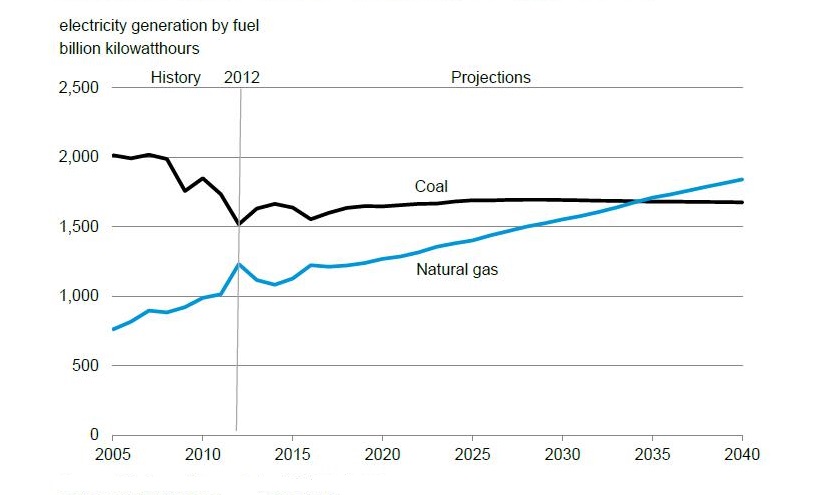BLOG ENTRY: Coal, Natural Gas, Nuclear, and Solar Power
Coal, natural gas, and nuclear power have all been discussed widely in the larger attempt to have an “all of the above” energy policy in the United States. The three are a large portion of American energy generation and consumption, and have long been part of the overall energy independence conversation. As seen in the graph below, in addition to petroleum, the three make up a vast majority of US energy consumption. (The graph is dated back to 2007, however renewable fuels have yet to capture a large portion of American energy usage).
A key element to this conversation has centered around the environmental impact of each of the different energy sources. First and foremost, coal and natural gas are both criticized by environmental groups for having a negative impact on the overall battle against climate change. While natural gas emits less carbon than coal, both continue to be contributors to the American carbon footprint.
Specifically, the graph below underscores the carbon output from each area.
As argued in the class text, it’s imperative for both energy sources that the country invest in updating power plant technologies. While increased efficiency is possible to technological advancements, we have been slow to adopt such upgrades. CO2 emissions from gas combustion is 16% of our GHG emissions, and 29% comes from coal. We have the potential to dramatically reduce our coal emissions through the modernization of coal plants. Coal plants have an average 33% efficiency in the US according to Richter, and that number could be increased above 40% if newer technologies were employed.
Furthermore, all three are similar in the sense that they often bring about safety concerns. Nuclear power specifically, while emitting no carbon emissions, has been slammed due to radiation concerns and other safety issues. Furthermore, attempts to allow for storage of nuclear waste (such as in Nevada) have fallen flat due to environmental concerns. It has been argued that many of these criticisms are misguided and unfounded, as the plant in Chernobyl had none of the safety protections you would find in an American power plant (according to Richter).
Furthermore, due to concerns over radiation and safety, nuclear power has been the subject of many layers of red tape. The accident at Three Mile Island led to a large increase in orders from the Nuclear Regulatory Commission. Regulatory costs and public backlash have not allowed for a construction if a new nuclear power plant in decades, with approval of the energy source below 50% for many years. The graph below, from the US Department of Energy, underscores that some of the concerns over radiation may be groundless.

While the overall reason for the lack of construction is subject to debate, Forbes Magazine reports that harsh competition from natural gas and coal production is also a piece of nuclear power’s struggle to keep up in the U.S. It should be noted that coal is also facing a decline in comparison to natural gas growth. Despite hopes for a turnaround due to the drop in coal costs, natural gas continues to expand rapidly due to the usage of fracking. Coal and nuclear power have leveled out, while natural gas has continued to thrive in the new economy.

A concern I have about the overall image of the three energy sources is that there seems to be a perception that they are all villains in the fight for environmental protection. While it is ideal that renewable fuels take the lead, it’s unlikely that such fuels could truly power the American economy in the near future. With increased research in carbon capture (as suggested by the class text), a modernization of natural gas plants, and increased oversight of nuclear power, the American public could reap the benefits of increased energy independence while concurrently driving down carbon emissions.

On the political end, the President has spoken out in support of increased nuclear power production. Furthermore, Obama spoke positively of natural gas production as a pathway to lowering emissions in recent energy speeches. On the other hand, the administration has been cool towards increased coal production and has proposed carbon standards that would likely raise costs for coal-based power plants. With these policies in place, I would expect continued decline in coal for America’s energy future.
I want to briefly discuss solar power, in addition to the big three highlighted prior. Solar energy is divided between solar photovoltaic and solar thermal electrical generating systems. In the heat and hot water system, water is pumped to the rooftop where it is heated by the sun. The hot fluid goes to a storage tank, where domestic water is pumped through a coil inside the tank. The hot water can then be used for a variety of reasons. Photovoltaic installations have been increasing, with the first cell being developed in the 1950’s. The concern is the lack of efficient storage of the energy produced.
Solar thermal electric systems can store energy, but they cannot produce much energy on an overcast day and the added cost of steam systems make it unlikely to be a viable alternative. Solar power is extremely environmentally friendly in a carbon sense, despite concerns that it takes too much space. I wanted to demonstrate that while it is a good alternative, it lacks a lot of the technologies needed to fully replace fossil fuels. The big three discussed prior can be modernized and made more efficient.

Investments should continue into carbon-free renewable fuels. With that said, it cannot and should not be the sole focus of carbon reduction activists. Whatever the mix may be, carbon emissions are continuing to be a greater concern for the overall public and will likely play a big role in future energy generation decisions.
Sources:
http://www.npr.org/2014/02/14/276782467/report-burning-natural-gas-is-better-than-using-coal
http://www.eia.gov/tools/faqs/faq.cfm?id=427&t=3
Class Text: Beyond Smoke and Mirrors by Burton Richter

One Response to BLOG ENTRY: Coal, Natural Gas, Nuclear, and Solar Power